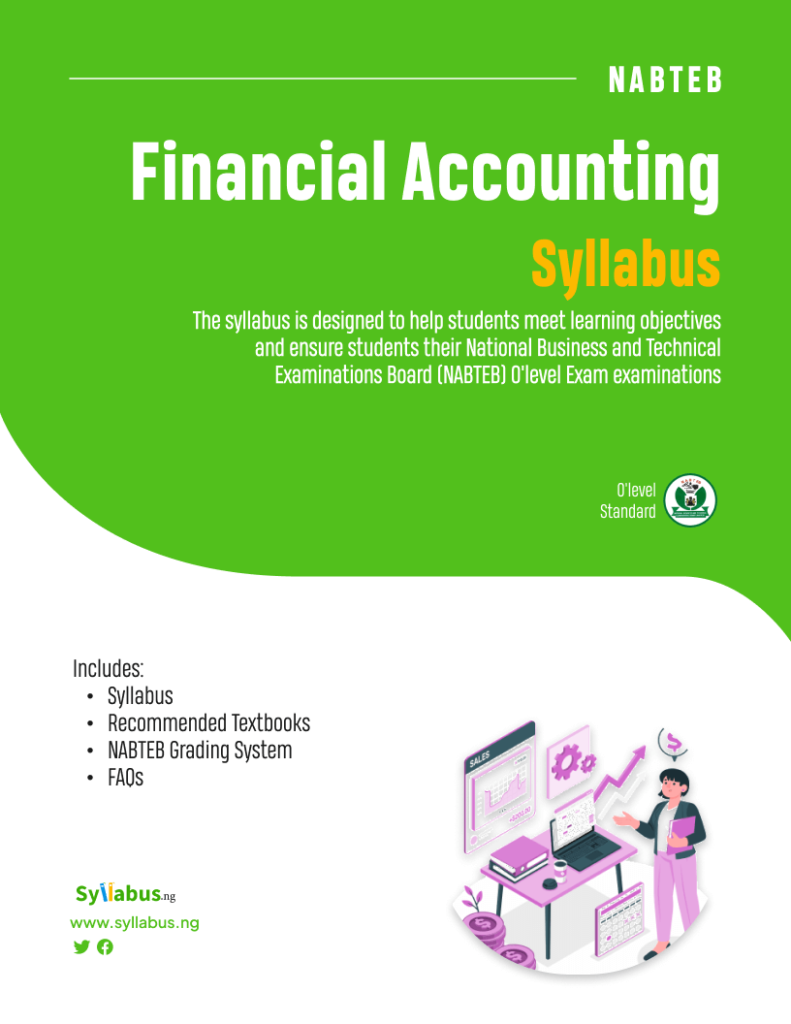NABTEB Fishery Syllabus
Writing NABTEB O’level exams? Download the National Business and Technical Examinations Board (NABTEB) recommended syllabus to excel in your Fishery exams. Take the first step in studying smart today.

Home » NABTEB Syllabus » NABTEB Fishery SyllabusAbout NABTEB Fishery Syllabus
Will you be writing Fishery in the upcoming NABTEB exams? Then this syllabus is for you.
This syllabus for Fishery tells you all you need to know about the upcoming exams. From the topics to the objectives down to the recommended textbooks, you can read with. It is a valuable resource that you and your classmates will enjoy having so do well to share this with them.
Reading this syllabus and practising your past questions will give you an edge over other candidates who focus on just their school notes and materials.
AIMS:
This subject is designed to:
1. acquaint students with the knowledge of physical geography and its relevance to fisheries science.
2. introduce students to the general overview of fisheries.
3. acquaint students with the general principle of aquaculture particularly as it affects warm water fish species;
4. teach students the basic principles of designing, constructing, and using common fishing gear and crafts in Nigeria;
5. enable students to understand the basic design and construction of simple fish culture facilities and how to maintain them.
6. acquaint the students with the knowledge of fish handling preservation, processing, and marketing.
Marking Guide
There will be two papers in this exam
PAPER I: will consist of two sections;
SECTION A (OBJECTIVE):
This section will comprise forty (40) multiple-choice questions Candidates will be required to answer all in 40 minutes.
This section carries forty (40) marks.
SECTION B (ESSAY):
This paper will consist of six questions and candidates will be expected to answer four questions for 2 hours.
This Section carries sixty (60) marks.
PAPER II (PRACTICAL):
This will comprise two (2) compulsory Practical Questions for three (3) hours and will carry 100 marks.
Download NABTEB Fishery Syllabus

Best candidates excel because they study smart and hard. Know what’s expected of you.
Download the NABTEB recommended Fishery Syllabus
Fishery Syllabus for NABTEB Exams
| NABTEB FISHERY SYLLABUS | |
| TOPICS | OBJECTIVES |
| FIT 13 – INTRODUCTION TO PHYSICAL GEOGRAPHY | |
| THE RELEVANCE OF PHYSICAL GEOGRAPHY TO FISHERIES | i. Definition of Physical Geography ii. Components of Physical Geography relevant to fisheries sciences. iii. The components of fisheries science. iv. Types of environment in which fishes lives. v. The physical and chemical characteristics of the following: a. fresh water b. brackish water c. marine water vi. Identification of lakes, estuaries and deltas in natural situations and maps. vii. Differences between lakes, rivers, lagoons and estuaries. |
| NAME & LOCATIONS OF CONTINENTS, OCEANS AND RELIEF FEATURE S OF THE BASINS IN THE WORLD | i. The world map ii. The ocean of the world on map iii. Differences between mountains, hills, valleys and other land configuration. iv. Explanation of land configuration to types of lakes, rivers and other water bodies |
| WEATHER INSTRUMENTS | i. The use of the following instruments: a) rain guage b) thermometer c) hygrometer d) barometer e) wind vane f) sunshine recorder ii. The use of weather records to fisheries science. |
| FORMS OF LIFE IN ACQUATIC ENVIRONMENTS | i. Importance of phytoplankton and zooplankton in aquatic environment ii. Identification and drawing important invertebrates (crustaceans mainly) iii. Explanation of importance of crustaceans in aquatic environment. iv. Identification of fin and shell fishes in the sea and their adaptive features. v. Identification of common aquatic weeds in Nigeria. |
| FIT 21 – INTRODUCTION TO FISHERIES | |
| BASIC FISH ECOLOGY | i. Identify different types of fish. ii. Fish grouping into: a. Fin Fish b. Shell Fish c. Bony/Cathogeneous fish d. Habitat (Ecology) fish iii. External Features of fish and their functions. iv. Internal Features of fish and their functions. v. Growth, feeding and reproduction of fish. |
| FISHERIES DEVELOPMENT IN NIGERIA | i. Importance of fish in human nutrition. ii. History of development of fisheries Industry from pre-independence Nigeria to date. iii. Status of fisheries resources production in Nigeria economy. iv. The roles of the following fisheries sub-sector economy: a. Artisanal (Subsistence, Small- Scale and Commercial) b. Industrial c. Aqua-Culture. v. Problems associated with each sub- sector. vi. Possible solutions |
| CONCEPT OF FISHERIES TECHNOLOGY | i. Explanation of the following concepts a. Fish technology b. Fishing technology c. Fisheries technology. |
| FISH CLASSIFICATION | i. Basic Principles of fish classification. ii. The difference between fin fishes and shell fishes. iii. Main groups of Nigerian fishes (marine, Brackish water and fresh water species) and their diagnostic features as well as main characteristics. |
| EXTERNAL MORPHOLOGY OF BONY FISH | i. Morphmetric or meristic characters of fish i.e. standard length, total length, trunk, head girth, head trunk and tail region of a typical fish. ii. Different types of fish scales – Ctenoid, Ganoid, Cydoid and Placoid. iii. Methods of identifying and drawing fish skin. |
| INTERNAL FEATURES OF BONY FISH | i. Identifying the following feature of a fish. a. The elementary canal and associated structures – mouth, teeth, pharynx, esophagus, stomach, intestine, pancreas, liver, kidney, spleen gas bladder, gills, gonads and heart of fish b. Dissecting and drawing to scale fish alimentary canal relative to body length |
| FISHERIES DEVELOPMENT IN NIGERIA II | i. Fisheries sub-sector in Nigeria: a) Artisanal (Subsistence, Small scale and commercial) b) Industrial c) Aquaculture |
| FIT 22 – BASIC AQUACULTURE | |
| AQUACULTURE | i. Definition of aquaculture. ii. History of aquaculture with particular reference to Nigeria, the present status and its prospects in future. iii. The potential of aquaculture in boosting fish production in Nigeria. iv. Identification of major fish types in Nigeria, fish seed, table fish, ornamental fish, shall fish. v. Key species of fish cultured in Nigeria. |
| FISH CULTURE SYSTEMS | i. Definition of extensive, semi- intensive and intensive farming systems. ii. The differences betweens extensive, semi-intensive and intensive fish farming systems. iii. Various facilities for the culture of fish. |
| NATURAL & SUPPLEMENTARY FISH FEEDS IN PONDS | i. Explanation on natural and supplementary fish supplementary fish feeds. feeds in ponds. ii. Methods for the production of natural fish food. iii. Procedure for compounding simple fish rations. iv. Locally available common fish feed stuffs. v. Practical feeding of fish. vi. Production of fish feed pellets. vii. Packaging of fish feed pellets. |
| ENEMIES OF FISH UNDER CULTURE | i. Definition of water pollution. ii. Identifying ways of dealing with problems of water pollution in fish culture. iii. Simple methods of improving water quality. iv. Identifying fish predators and control. v. Identifying aquatic weeds and control. vi. Common fish diseases and parasites and how to control them. |
| CONSTRUCTION & MANAGEMENT OF AQUARIUM | i. Definition of aquarium. ii. Materials for construction of an aquarium. aquarium. iii. Types of aquaria (natural & artificial). iv. Some of the natural plants found in an aquarium. v. Some common ornamental fishes found in an aquarium. vi. Common fish feed used in aquaria. vii. Methods of maintaining acquaria |
| FIT 22 – BASIC AQUACULTURE (PRACTICAL CONTENT) | |
| AQUACULTURE | i. Key species of fish cultured in Nigeria. ii. Major fish types in Nigeria fish seed table fish, ornamental fish, shell fish. iii. Different culturable fish species: a. Tilapia b. Clarias c. Heterobrachus d. Cyprinus Caspio e. Heterotis nitotians |
| TYPES OF FISH CULTURE SYSTEM | i. The facilities for the culture of fish. ii. Preparation of ponds for stocking. iii. Stock pond as desired iv. Methods of compounding simple fish ratio. v. Practical feeding of fish. |
| FISH SEED PRODUCTION | i. Packaging fish fry/finger lings for transportation. ii. Definition of hypophysation of fish |
| FISH HARVESTING | i. Equipment used for harvesting fish by a. partial and b. total cropping. ii. Methods of harvesting and crop fishing by total or partial cropping. |
| ENEMIES OF FISH UNDERCULTURE | i. Fish predators and minor control. ii. Aquatic weed. iii. Common fish diseases and parasites and how to control them. |
| THE CONSTRUCTION OF AQUARIUM | i. Materials for construction of an aquarium. ii. Types of aquarium (natural & artificial). iii. Natural plants found in an aquarium. iv. Common fish seed used in aquaria. v. Common ornamental fishes found in an aquarium. vi. Construction of Aquarium. |
| FIT 23 – FISHING GEAR AND CRAFT TECHNOGY (PRACTICAL ONLY) | |
| CLASSIFICATION OF FISHING GEAR | i. Identification of all the traditional and modern fishing gear in use in Nigeria. ii. Classification of fishing gears and method under: a. Active fishing gears (trawl, cast net, seine nets, claps nets etc.) b. Passive fishing gears (gile net, trammel nets, traps etc. |
| NETTING MATERIALS FOR GEAR CONSTRUCTION | i. Natural fibers materials for net construction. ii. Synthetic materials for net construction. iii. Physical characteristics of synthetic fibers (flexibility, strength etc.) iv. Identification tests on the various types of synthetic fiber (water and visual tests) |
| BASIC PROCESSES OF NET CONSTRUCTION | i. Definition of terms associated with net construction viz: normal and T- cut, bar cut, combinations cut etc. ii. Processes in net construction, braching, strand formation (rope), tapering, creasing, joining, knotting etc. iii. Mount netting material on support ropes (head and ropes). iv. Explanation on hanging ratio (coefficient) and its effects on shape of net and its application constraints. v. Construction of mount net using 50% and 60% hanging. |
| TYPES OF FISHING CRAFT/BOAT | i. Description of a typical fishing craft. ii. classification of crafts into calabash; bamboo rafts (aids) canoes, dingy, boats, and trawlers etc. iii. Different types of fishing boat e.g. wooden, glass fiber, steel, ferrocement etc. iv. The difference between mechanized and non-mechanised boats. v. Simple tools for building boats. vi. Drawing of a simple fishing boat plan. vii. Identifying different boat parts. viii. Designing simple fish boat (model). |
| FIT 31 – INTRODUCTION TO FISH FARM ENGINEERING (PRACTICAL ONLY) | |
| SELECTION OF SITE FOR FISH FARMS | i. Definition of fish farm engineering. ii. Reconnaissance survey of farm site for vegetation, water source/quality, topography etc. iii. Determination of elevation and distance using simple instruments like hand level, kern levels, ranging poles, tape etc. iv. Simple soil suitability testing e.g permeability tests, soil structure, soil PH. v. Simple water quality test on water source temperature, turbidity, dissolved oxygen, PH, ammonia, iron, lead etc. |
| DESIGN OF SIMPLE FISH FARMS STRUCTURES | i. Identification of common structures found in fish farm e.g. pond, sluice gate, wooden tank, fibre glass tank, concrete tank etc. ii. Design of fish farm structures such as: a. Earthen pond e.g. barrage, contour etc. b. Other holding facilities e.g. aquarium tank, concrete tank, horrestead pond, raceway, plastic tank, wood/plank tank, fibre glass tank. iii. Simple outline design of ancillary farm structures e.g. store, net rack, hatchery, counting shed, reservoir etc. iv. Sketch pond dyke core trench. |
| CONSTRUCTION OF FISH FARMS FACILITIES | i. Identifying the following devices: dyke (dam), Monk, Dyke Protection devices, Sluice gate, spillway etc. in fish farm facilities. ii. construction of a typical earthen fish pond. iii. Construction of horrestead/Concrete Pond, aquarium, transportation tank. iv. Determination of fish to water surface area requirements for stocking based on size and species. v. Management of dyke protection devices. vi. Assembling a model earthen pond aquarium tank, hapa/cage, and pen. vii. Setting up other small fish farm holding structures e.g. fiber glass tank, plastic bowl, wood/plank tank etc. viii. Cutting of glasses using diamond |
| THE CONCEPT OF HATCHERY DESIGN | i. Description of the various types of hatchery e.g. indoor, outdoor. ii. Description of other supporting structures e.g. Nursery pond. iii. Identification of incubator, tank, brood stock tank etc. |
| FIT 33 – INTRODUCTION TO POST HARVEST TECHNOLOGY AND MARKETING | |
| NUTRITIVE VALUE OF FISH IN DIET | i. Description of the various types of hatchery e.g. indoor, outdoor. ii. Description of other supporting structures e.g. Nursery pond. iii. Identification of incubator, tank, brood stock tank etc. |
| FISH HANDLING METHODS | i. Common fish handling equipment: a. aboard b. landing site c. off shore ii. Operation and maintenance of common fish handling equipment. iii. Various handling methods affecting fish quality. iv. The effect of gutting on keeping quality of fish. |
| CAUSES OF FISH SPOILAGE | i. The causes of fish spoilage. ii. Factors responsible for spoilage of fish: a. Bacterial b. Enzymes c. Chemical Oxidation iii. Locations of micro organisms on the fish body. iv. Spoilage microorganisms and their control measures |
| TECHNIQUES OF EVALUATION OF FRESHNESS OF FISH | i. Physical properties of freshly caught fish e.g. eyes, gut, gill appearance and flesh. ii. Identifying changes that occur in fish stored at various temperature on the flesh, eyes, gills and general appearance. iii. Signs of deterioration in fish e.g. off colour, off odour, flassiness, taste |
| FIT 33/ INTRODUCTION TO POST HARVEST TECHNOLOGY AND MARKETING (PRACTICAL CONTENT) | |
| METHODS OF FISH PRESERVATION AND PROCESSING METHODS | i. Description of the various fish processing and preservation methods e.g. boiling, frying, smoking, sun drying, salting, fermentation, canning, freezing, icing. ii. Equipment for each method in 5.1 above. iii. The differences between icing, freezing and cold storage. iv. The advantages and disadvantages duration of each of the method in 5.1 |
| FISH MARKETING | i. Forms of fish for marketing. ii. Various outlet for marketing the following: a. fish seed b. Table (fungaling) fish c. Shell fish d. Ornamental fish iii. Explanation on the constraints associated with fish |
FAQs
There is no official pass mark, but scores above 50 are considered good. However, you should try to score as high as you can because the higher you score, the better your chances of admission to your chosen course and institution.
The entire exam takes 5 hours 40 minutes. We would advise you to spend about 3-5 minutes on each question so you can have enough time to go over your work again. Do not spend too much time on questions you do not know.
The NABTEB Fishery exam covers topics like basic fish ecology, aquaculture, fish harvesting, fish spoilage and causes, etc. A full list of topics to study is listed above.
Each section in the exam has its allocated mark and your score will be based on how well you do in every section.
Paper 1 has two sections; the total number of marks for section A is 40 marks and for section B, it is 60 marks.
Paper II is the practical section which will carry 100 marks.
Yes, some schools abroad accept NABTEB results in place of WAEC but it all depends on the school and program you are applying for.
You will be required to answer 40 multiple-choice questions, 4 theory questions, and 2 practical questions based on the syllabus listed above.
Here are a few tips for you; Start studying early enough. Do not do last-minute reading. You should also try practicing your time management skills.
Another tip is to study past questions regularly and ensure you get a good night’s rest a day before your exam.
Good luck!
Download NABTEB Fishery Syllabus

Best candidates excel because they study smart and hard. Know what’s expected of you.
Download the NABTEB recommended Fishery Syllabus











